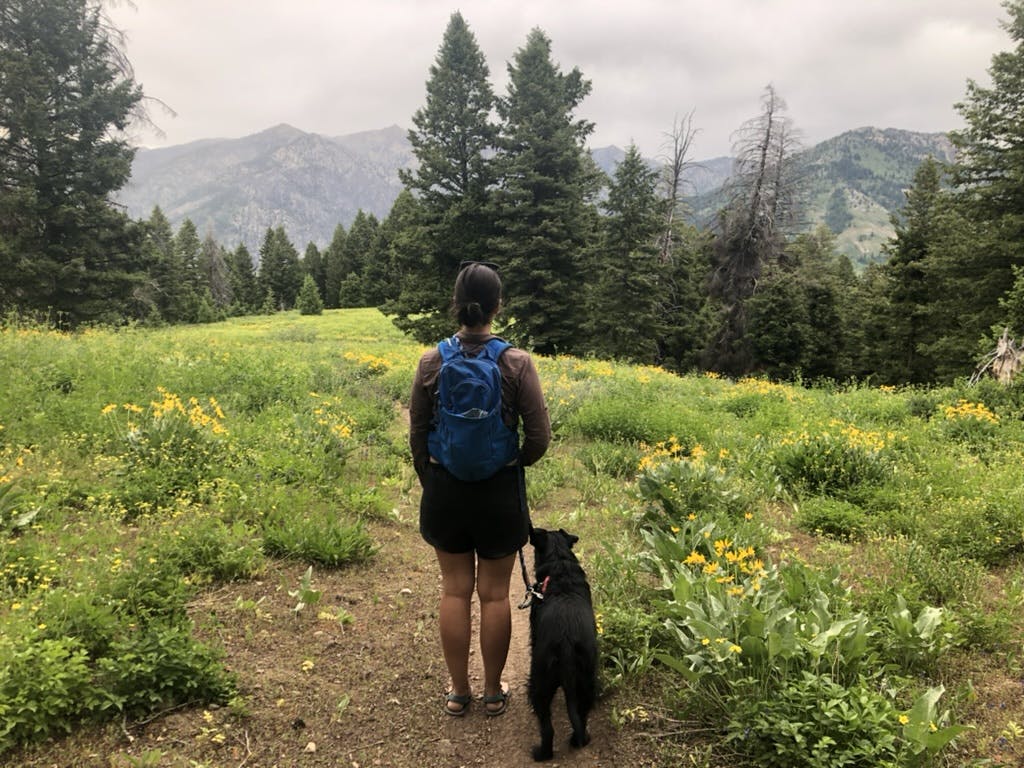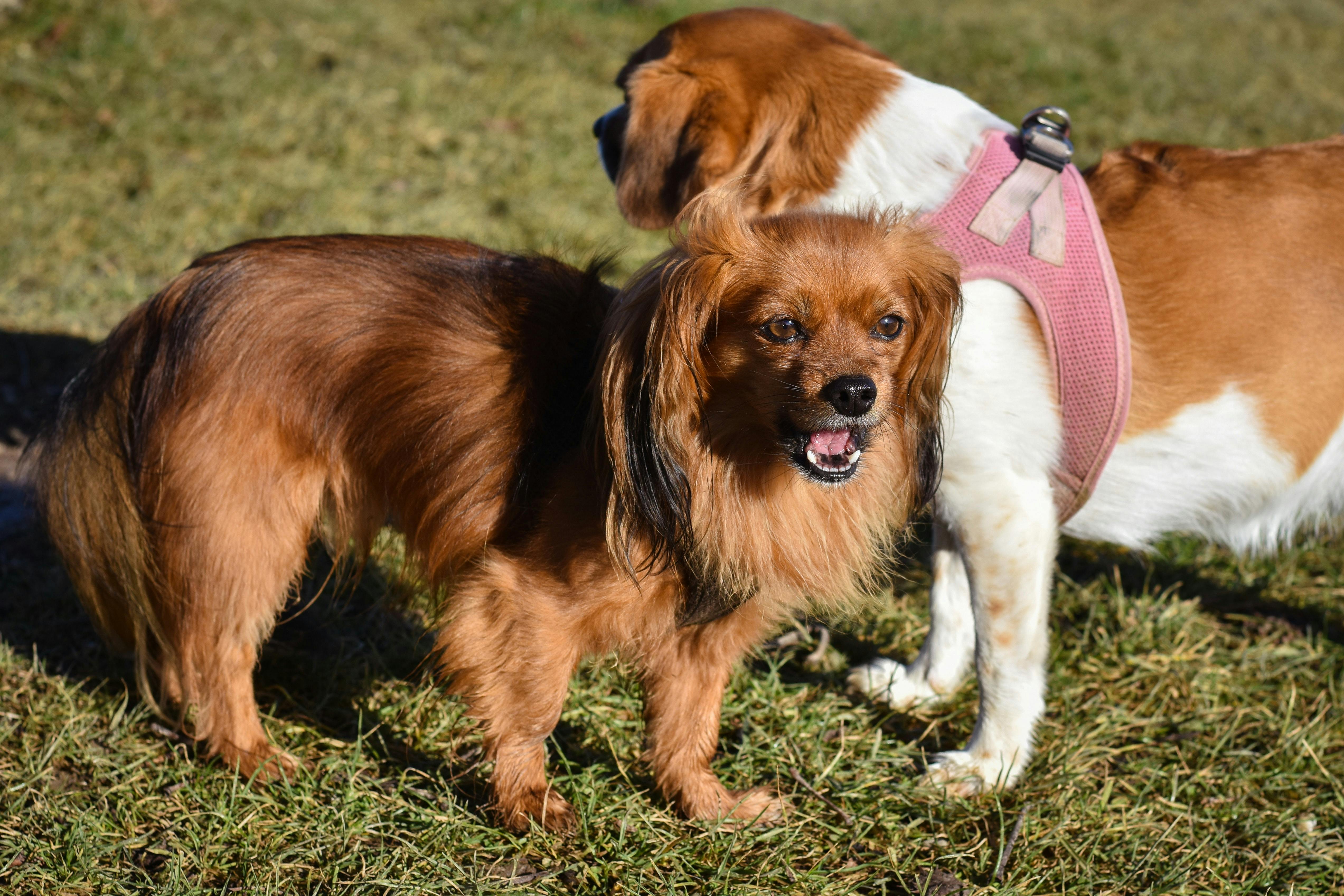Get Your Free Reactive Dog Masterclass
Unlock the secrets of rehabilitating your reactive dog with this masterclass video
The black smudge of a dog was barely visible through the bars of his kennel.
Still, I stopped and read the paper tacked to the wall.
Hi, I’m Dunkin, the paper read. I’m a social butterfly.*
Immediately, I asked one of the Humane Society workers if my partner and I could meet him.

This is a picture of my partner playing tug with Dunkin (renamed Scott) the day we met him and took him home.
I dreamed of adopting a dog since the day I went to college and had to leave my childhood dog behind. Before that point I had lived with a dog—for all but a handful of months—from the age of two on.
Of course, I knew that a dog + the fanciful and busy college years weren’t a good mix. So, I waited until graduation and a few years afterward for financial stability.
By the time I walked into that Humane Society, I was not only ready for a dog but salivating for one.
I imagined being that friend who brings their dog everywhere—I fantasized about taking my dog camping, swimming, to the park, to breweries, on vacations, everywhere.
I wanted that dog you see on TV.
Maybe he’d be a bit mischievous. He might steal a bite of pizza if left on the counter. He might wear me down with those big puppy eyes to sleep in the bed and proceed to hog all the covers. Maybe he’d even flop into mud puddles and shake off way too close to me, splattering mud droplets all over my cheeks.
But at the end of the day, he’d be an easy, fun, social butterfly of a dog.
My partner and I were ushered into a sparse room with a bucket of tennis balls and squeaky toys. The Humane Society worker brought Dunkin to meet us.
He was 30 pounds of scruffy hair with the biggest, brownest eyes that melted me to my core. He played fetch with a tennis ball. He played tug with a squeaky toy. He even laid down and relaxed.
He was perfect.
We took him home that day.

This is a picture of me hugging Scott in the car right before we drove home. Note how stressed he looks here (pinned ears, stiff body, panting when it was winter, and that whale eye). I didn't notice his body language at the time.
If this were a movie, that day would have been in full vibrant color.
Seven days later, our life was drenched in sepia tones.
Dunkin—who we renamed Scott—started to bark. At everything.
Primarily, he barked at my partner and I. He would stand there, staring at us with those eyes that once melted our hearts and now seemed to sear our nerves, and bark.
It was the worst at night. He would pace around our bedroom—we originally tried to have him sleep in his crate and that did not work (a story for a different time)—and every few minutes put his paws on the bed and bark his heart out. For hours and hours and hours and hours.
He also struggled with separation anxiety and couldn’t be left alone. In fact, he always seemed to be anxious or upset or sad. He didn’t wag his tail ever. He avoided sunlight. He never rested.
My parents came over for sushi one night, saw our dark circles and bleary eyes, and joked that we looked like the parents of a newborn.
The Humane Society said we could return Scott within thirty days for a full refund. We considered it, but thought Scott was simply readjusting to his new life and would be a “normal” dog soon. We also couldn’t stomach the idea of him rotting in that doggy cell for another hour. He was a part of our family.
He didn’t just bark at us though. He barked at every sound and, when on walks, seemingly everything that moved—bicyclists, skateboarders, people, cars sometimes, and other dogs. He wasn’t above barking at plastic bags if they moved too suspiciously.
We increased his exercise regime because we heard that a tired dog is a well-behaved dog. This only made things worse. We started doing trick training with him to teach him a litany of circus tricks. This did improve things. We tried doggy essential oils. This didn’t have much of an effect either way.

This picture shows one of Scott's circus tricks of jumping on our backs.
Eventually, my partner and I found a sleeping routine that “worked.” We sat in the bathroom while Scott paced around the bedroom. That way he could see us—we tried leaving completely which only escalated his anxiety—but he didn’t like the bathroom, so he wouldn’t engage with us.
He paced for thirty minutes to an hour, barking occasionally, until he tired himself out and fell asleep on the floor. We would tiptoe into the bedroom—careful not to wake him—crawl under the covers and fall asleep thinking that maybe this demon dog knew that sleep deprivation was a torture technique and had been sent by the government to suss out our secrets. (Not really, but a part of me had wondered if he was behaving this way out of spite or maybe because he was broken?)
Now, a certified dog trainer, I can contextualize all of his “bad” behaviors and understand why certain interventions worked where others failed. At the time, I was clueless.
After one particularly rough day and night, I laid beneath the covers scrolling on my phone and discovered the term “reactive dog.”
I told myself that Scott wasn’t reactive. That label felt too harsh, too permanent. He merely had reactive tendencies.
I wouldn’t yet accept the label, but I did absorb some good advice that night.
I learned that it was possible to overstimulate dogs (which we were definitely doing to Scott.)
I also learned about the Relaxation Protocol, which taught Scott to be able to relax and come down from a higher state of arousal. I credit the Protocol with solving our sleep problem for good.

We were well-rested. Scott seemed trainable. Things were looking up.
Until.
My partner and I moved.
At this point—keeping with the metaphor—the movie went completely dark with dramatic clap of thunder and streak of lightning for good measure.
The day we moved, Scott slipped out the front door and went after our neighbor’s dog. I won’t go into details other than to say it was traumatic (and the other dog was okay).
I cried. I raged. I didn’t even want to see Scott. For a full day, I thought I might hate him.
Days passed and I calmed down. My partner and I discussed what to do and—ultimately—decided to keep the dog. We didn’t have children or any other pets. I worked from home. We had the time and resources to deal with this dog who might not get another chance.
And, despite everything, we loved Scott.

An early picture of Scott and me. I wouldn't recommend putting an arm around a dog like this—especially if they're new to your home—but I didn't know that at the time.
When he wasn’t being awful, he was wonderful. We loved teaching him to jump into our arms, to play dead, to whisper a secret in our ear. We loved playing tug-of-war with him and half-heartedly attempting to teach him to fetch. We loved when he would occasionally let us cuddle him. (He wasn’t cuddly for the first two years with us, but now he enjoys a good snuggle. Another story best left to another time.)
This is when we got serious. (Cue the Rocky theme song.)
I accepted that he was reactive. I researched reactivity and researched some more. We read books, took online classes, and committed to training protocols.
For years, I trained Scott nearly every single day, including bi-weekly sessions with trusted dogs to address his dog reactivity. We put him on medication. I researched, read, and trained some more. We made mistakes along the way.
Sometimes, I regretted adopting him as difficult as that is to admit. I remember after one particularly rough walk where he had a huge barking, lunging fit toward another dog, screaming into my pillow. I hated that every time a "friendly," off-leash dog came running up to us that my heartbeat skittered a mile a minute, my palms sweated, and I had to explain that my dog wasn't friendly. All while the friendly dog owner's mouth tightened and eyes narrowed like I was in the wrong for taking my dog on a walk because he was afraid of other dogs. All while I resisted snapping at them that they needed to leash their dog because leash laws exist for a reason, knowing that would only escalate the situation and, for the sake of both dogs, I needed to get out of there. (Seriously, this type of thing happened multiple times. Only once—once!—when I said my dog wasn't friendly did a man apologize, leash his dog, and treat me with kindness. I've now accepted that it's their problem, not mine.)
But, overall, we were seeing steady progress. Scott was becoming more "normal," while we were accepting his limitations.
A little less than two years after adopting Scott, I attended the Karen Pryor Academy to become a certified, professional dog trainer.
Today, he’s a different dog than the one we brought home four years ago. Ninety-percent of the time he acts like a normal dog. I’ve been complimented on how well-behaved he is numerous times on walks while I think to myself, little do these people know how far we've come.

But he’s still not a social butterfly.
He’s not that perfect pop culture dog—and he will never be. He’s still easily overstimulated, does not like stranger dogs, and exists with a level of underlying anxiety that other dogs don’t have to deal with.
I don’t let him off-leash. I don’t take him camping or swimming (he’s afraid of water, of course). I leave him behind most of the time.
Yet, he’s my Scott.
I’m proud to be his dog guardian, as difficult as it’s been.
We have a deep bond from all the training and behavior modification we’ve done together. I melt when he’s soundly sleeping on the couch—such a simple thing he wasn’t able to do all those years ago—paws and nose twitching, snores rumbling the foundation of my home. I’m flooded with oxytocin when he chooses to lay his head on my leg. I’m thrilled for him when he wags his tail (which is all the time these days) or relaxes in a pool of sunshine.
I’m more patient than I ever thought possible. I know how to reconcile the seemingly opposing feelings of loving him, shuddering at what might have happened to him if we hadn’t brought him home, and resenting the changes he brought into my life. Yes, I still sometimes resentful. I’m less-judgmental of other people’s dogs (I was a bit of a judgmental snob before).
I wanted to be vulnerable and share my reactive dog experience—from the perspective of an owner not a trainer—to help anyone in a similar situation who might be feeling alone. It’s difficult to own a reactive dog and it’s not frequently talked about, although I now know that it's actually quite common.
So, if you’re in the middle of your reactive dog journey, I see you. I am with you. And I wish you all the best.
*I don’t blame the Humane Society for saying he was a social butterfly. It’s difficult to know a dog’s disposition when they’re in a shelter environment.









